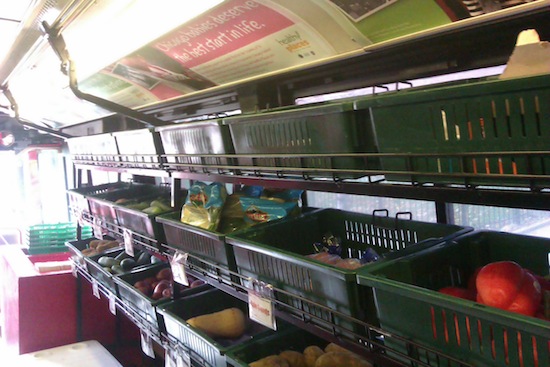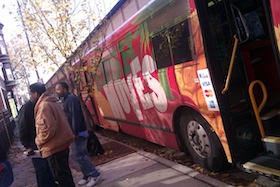Serving up fruits and vegetables, partnership works to improve access

Chicago-based Fresh Moves has been working to improve access in “food deserts” by providing mobile produce markets for people in West and South Chicago.
Photos courtesy of Lydia Zepeda
Access to fruits and vegetables is something many people take for granted. But for those who live in “food deserts” — areas where food stores and produce aren’t readily available — it’s an obstacle to healthy eating.
Chicago-based Fresh Moves has been working to improve access by providing mobile produce markets for people in West and South Chicago. Fresh Moves Executive Director Julian Champion will talk about the issue during “Fresh Moves: Providing Healthy Foods to Chicago’s Food Deserts” from noon to 1 p.m. Tuesday, Dec. 4 at the Morgridge Center for Public Service in the Red Gym, 716 Langdon Street.

Bananas, honeydew melon, corn, tomatoes — all come to neighborhoods courtesy of a revamped Chicago transit bus.
The issue isn’t just about access. It’s also about education, Champion says.
“We are bringing fruits and vegetables to communities that don’t understand in a real dynamic way that they need fruits and vegetables,” Champion says. “It’s something they’ve lived without.”
Bananas, honeydew melons, corn, tomatoes — all come to neighborhoods courtesy of a revamped Chicago transit bus. Last year, Fresh Moves received the 2011 People’s Choice Award at the 10th annual Chicago Innovation Awards, besting 400 other projects.
Lydia Zepeda, a professor of consumer science, is conducting a USDA Ag Marketing Service research project on mobile food markets. Four mobile markets are being studied for the project, including Fresh Moves.
The aim of the research is to measure the effects of mobile markets on healthy food choices, who uses them, and what improvements can be made.
“Mobile markets are an old and new idea at the same time,” Zepeda says. “Basically, we’re bringing produce to the consumer. That’s something that used to happen a lot more and the idea is coming back around again.”
Food deserts have been created, in part, because retail stores have left poor neighborhoods. Often the only stores that remain that sell food are convenience stores, corner groceries or bodegas, or even liquor stores. Since these stores are small, they tend to carry higher value, nonperishable foods, rather than perishable, low-margin produce.
“Basically, we’re bringing produce to the consumer. That’s something that used to happen a lot more and the idea is coming back around again.”
Lydia Zepeda
Another factor contributing to the existence of food deserts is growth in cities with added housing. Also, the profit margin for produce isn’t as high as other products. And it requires daily deliveries, unlike canned items.
Habits can be hard to change, especially dietary habits. In food deserts, people have become accustomed to buying inexpensive convenience foods because that’s what’s readily available, Champion says.
“If there were a demand for fresh fruits and vegetables, there would be stores selling fruits and vegetables,” Champion says. “It’s that simple.”
By pairing better access with education, Champion hopes to get people in the habit of eating more fruits and vegetables.
“We have a lot of work to do in terms of saying to communities we mean you strength and wellness by what we’re doing,” Champion says. “This is for your good.”
For some, mobile produce markets may help them discover a new favorite food they wouldn’t have otherwise tried.
“People eat what they like,” Champion says. “It’s that simple.”
With obesity and diabetes on the rise, getting people into the habit of eating healthy is even more critical, Zepeda says.
“We know that poor people have higher incidences of food-related diseases,” Zepeda says. “It’s so important that every American has access to healthy foods. These are preventable diseases. It’s a lot cheaper to prevent them than to treat them.”
